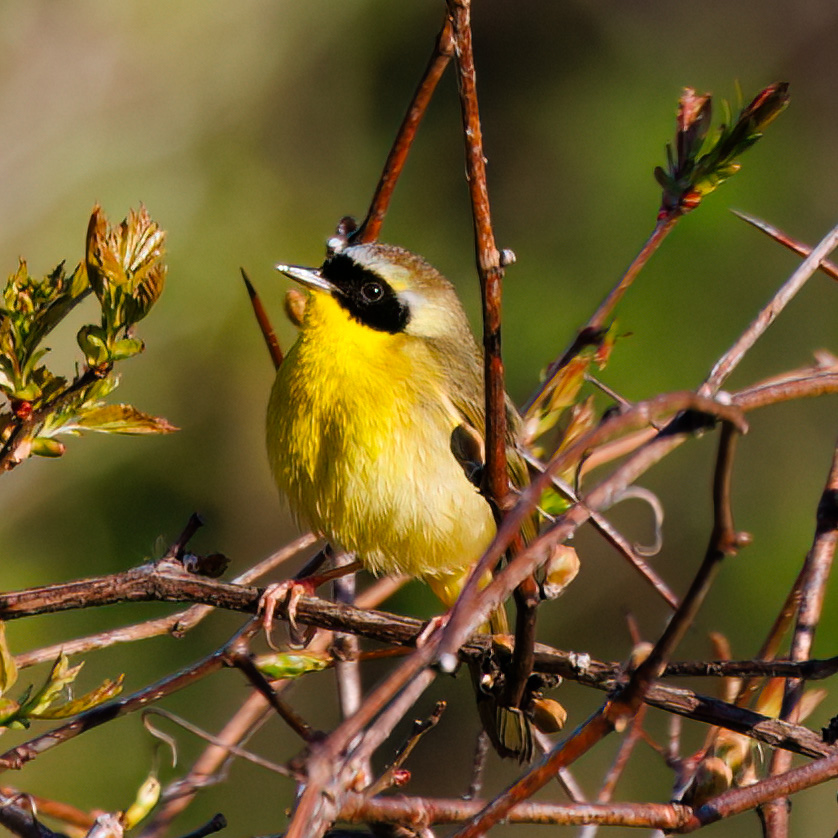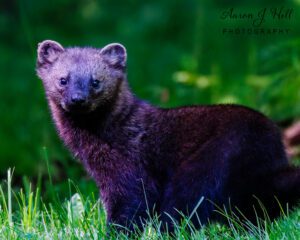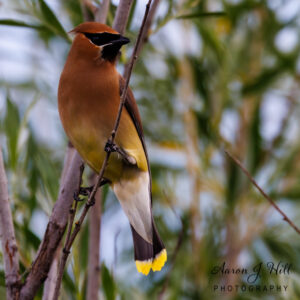The common yellowthroat (Geothlypis trichas) is a small North American warbler famous for its bold yellow
belly and distinctive black face mask. With its vibrant plumage, it’s a favorite among birdwatchers and
photographers looking for color and charm in wetland habitats. The male sports a broad, bandit-like
mask over bright yellow underparts, while the female is more olive-brown with only a faint hint of
yellow on her throat. This skulking little songbird is often easier to hear than to see; its energetic
“witchety-witchety-witchety” song and sharp call notes usually give away its presence in thickets.
For photographers, the common yellowthroat can be a challenging but rewarding subject. Using a long
telephoto lens, especially in spring or early summer when males sometimes sing from exposed perches,
can produce stunning images of its colorful plumage and distinctive mask. One excellent example is shown
above.
Despite being one of the most widespread warblers, the common yellowthroat’s secretive habits mean it
often stays out of direct sight. Birders note that yellowthroats are found in nearly every state and province,
favoring edges of wetlands, reedbeds, and brushy fields. In the north, many birds migrate south each winter (some traveling as far as Central America or the Caribbean), while southern and western
populations often remain in place year-round.
Common Yellowthroat General Description and Appearance
The common yellowthroat is a compact warbler about 4.5–5 inches (11–13 cm) long, roughly the size of a
sparrow. Its back and wings are olive green, contrasting with a vivid yellow throat and chest; the lower
belly is white . Adult males have the most striking plumage: a bold black mask across the eyes and
forehead, edged with a pale white or gray eyebrow stripe. In contrast, females look similar but lack this
mask; they have the same olive-and-yellow pattern but generally appear plainer overall. Immature birds
resemble adult females in color until they acquire their adult plumage in their first spring.
When flying or perched, a yellowthroat’s short, rounded tail (often pumped up and down) and compact
wings are noticeable . The outer tail feathers often have small white patches at the tips, which can
help confirm identification if glimpsed. Altogether, the combination of bright yellow underparts and (on
males) the bandit-like black mask makes the common yellowthroat unmistakable once it is close enough to
see.
Range and Habitat of the Common Yellowthroat
The common yellowthroat is a true North American warbler. It breeds from southern Canada through the
United States into central Mexico. In spring and summer it is found coast-to-coast, favoring
marshes, wetlands, and brushy fields. Because it relies on dense cover, yellowthroats tend to appear
in wet, shrubby areas rather than open forests or grasslands. In northern regions most birds migrate south
each winter (some traveling as far as Central America or the Caribbean) , whereas many southern and
western populations stay in place year-round. For example, one subspecies in the Texas Rio Grande
Delta defends its marshy home all year .
Preferred habitat is dense, low vegetation near water. The yellowthroat is the only North American warbler
that routinely nests in open marshes, often among cattails and reeds. You’ll often see it at pond or
stream edges where grasses and reeds are tall. It also inhabits boggy thickets, overgrown fields, brambles,
and tangles of weeds along riversides. These birds are generally scarce in very dry upland areas.
Yellowthroats can even use suburban wetlands if brushy cover is present. A large backyard with a dense
thicket of shrubs or tall grasses (especially near water) can attract a nesting pair.
Behavior and Vocalizations of the Common Yellowthroat
Common yellowthroats are energetic insectivores that forage actively in dense, low vegetation. They creep
through cattails and shrubs, gleaning small insects from leaves and stems. Sometimes a yellowthroat
will hover briefly to snatch prey off foliage, or flutter out to grab a flying insect mid-air. Insects
dominate their diet: caterpillars, beetles, grasshoppers, damselflies, mayflies, mosquitoes and other bugs
make up most of their meals . In winter or on migration they may also glean insects in dry brush or
eat small fruit.
During the breeding season the males are most easily detected by sound. A male common yellowthroat will
sing frequently, especially in the early morning or late afternoon, often from a perch atop a reed or shrub
. Its song is a fast, buzzing trill typically rendered as “witchity-witchity-witchity”. Many birders find
this flighty trill very recognizable in the thickets. The call note of a yellowthroat is a sharp chip or a low,
rolling chuck. If you hear a soft “chuck” coming from the undergrowth, there’s a good chance a
yellowthroat is nearby.
Behaviorally, yellowthroats are often seen flicking their tails as they move through vegetation. They usually
stay hidden low to the ground. While they can perch in shrubs or on cattail tops, they seldom fly high
into trees. The male will often perch atop a tall stalk to sing, as noted by Audubon. This habit can give
photographers a chance to spot one against the sky as it sings.
Overall the common yellowthroat is considered a resident (breeding) species in its preferred habitats during
summer. However, if disturbed it will dart quickly into cover. The best way to observe one is usually to
identify the habitat and sound, then patiently wait for it to reappear on an open stalk or branch.
Mating and Nesting Habits of the Common Yellowthroat
When it comes to breeding, common yellowthroats are socially monogamous but genetically promiscuous.
In most cases a male pairs with one female and both share parental duties. Intriguingly, studies show
that female yellowthroats may attract secondary “satellite” males with their calls, because females prefer
males with larger masks. Nevertheless, the bond between a male and his chosen mate is strong
during the season.
The female builds the nest, usually a loosely woven cup of grasses, leaves, and bits of bark hidden in a
tangle of vegetation close to the ground. She typically lays 3 to 5 creamy white eggs marked with brown
or black spots. The female incubates the eggs alone for about 12 days while the male brings her food. After hatching, both parents feed the nestlings; the chicks grow rapidly and usually fledge at about 8–10 days old. In most parts of its range, yellowthroats raise two broods per summer.
A major challenge for nesting yellowthroats is brood parasitism. Brown-headed cowbirds often try to lay
eggs in yellowthroat nests. Common yellowthroats have a remarkable defense: if a cowbird egg appears,
they will frequently abandon that nest and start a new one, rather than raising the cowbird chick . This
nest-desertion strategy helps ensure that their own young aren’t outcompeted by parasitic chicks.
Birdwatching Tips: Where and How to Spot the Common
Yellowthroat
Looking for a common yellowthroat? Spring and early summer are the prime times, when males are singing
to defend territory and breeding activity is high. Here are some practical tips to help you find and observe
these colorful warblers:
Habitat: Focus on marsh edges, wetlands, wet meadows, and any shrubby thickets with dense, low cover. Yellowthroats are unlikely in open woods or short grass fields.
Listen: Learn the song and calls. The male’s rapid witchity-witchity-witchity song and sharp chip/chuck
call are key giveaway sounds. In morning light, you’re likely to hear a singing male before
you see it.
Eye level: Keep your gaze down to mid-height. Yellowthroats usually stay close to the ground (often
only a few feet up). Scan tangles of vegetation rather than looking high into the trees.
Pishing: If you suspect a yellowthroat in the area, try gently making a pish or tseep sound. This often
piques the bird’s curiosity and may cause it to pop out of cover to investigate.
Be patient and stealthy: Move slowly and quietly through the habitat. Sudden movements will
scare yellowthroats into deeper cover. Wear muted clothing to avoid spooking these shy birds.
Use cover: Hide behind grass clumps or sit still near a likely spot. Yellowthroats may approach
inquisitively once they feel secure. A hide or long lens can improve your chances of a close view.
Backyards: If you manage a garden habitat, keep a dense thicket of shrubs or tall grass near a water
source. A large brush pile, hedges or overgrown patch can attract nesting yellowthroats.
For photographers, timing is key. Early morning light in a marsh not only provides good lighting, but
yellowthroats often sing from tops of reeds then. Use a long lens and be ready for quick action. If a
male fires off a song, watch where he lands – he may come to an open perch for a moment. Above all, enjoy
listening for the yellowthroat’s song and noting the flash of yellow. With its distinctive appearance and
voice, the common yellowthroat makes birding wetlands especially rewarding.
Interesting Facts
First of its kind: The common yellowthroat was one of the first New World birds catalogued; Carl
Linnaeus described a specimen from Maryland in 1766.
Masked bandit: The male’s black facial mask has earned it nicknames like “yellow bandit” and
“black-masked ground warbler”.
Marsh specialist: It is the only warbler that routinely nests in open marshes, often among cattails
and reeds.
Cowbird defense: Brown-headed cowbirds often lay eggs in yellowthroat nests. Common
Yellowthroats often abandon or rebuild a nest if they find a cowbird egg, rather than raising the
parasitic chick.
Long-lived: A banding study recorded an individual over 11 years old – quite old for a small
warbler.
Abundant: With an estimated population around 77 million, it’s one of North America’s most
numerous warblers.
Subspecies: There are 13 recognized subspecies of Common Yellowthroat. Birds from the Southwest
tend to have the brightest yellow underparts, while northern populations often look slightly duller.
Vocal females: Unlike many warblers, both sexes of yellowthroat sing. The female uses a softer
version of the male’s “witchity” song during courtship and territorial interactions.
These facts underscore what an adaptable and interesting species the common yellowthroat is. Whether
you’re adding it to your life list or capturing its bright plumage on camera, you’re sure to remember its
cheerful presence in the brush. Happy birding!



